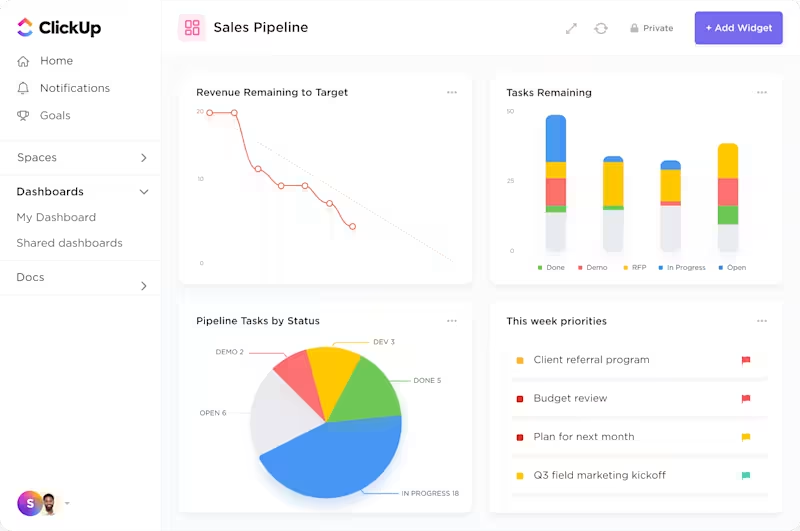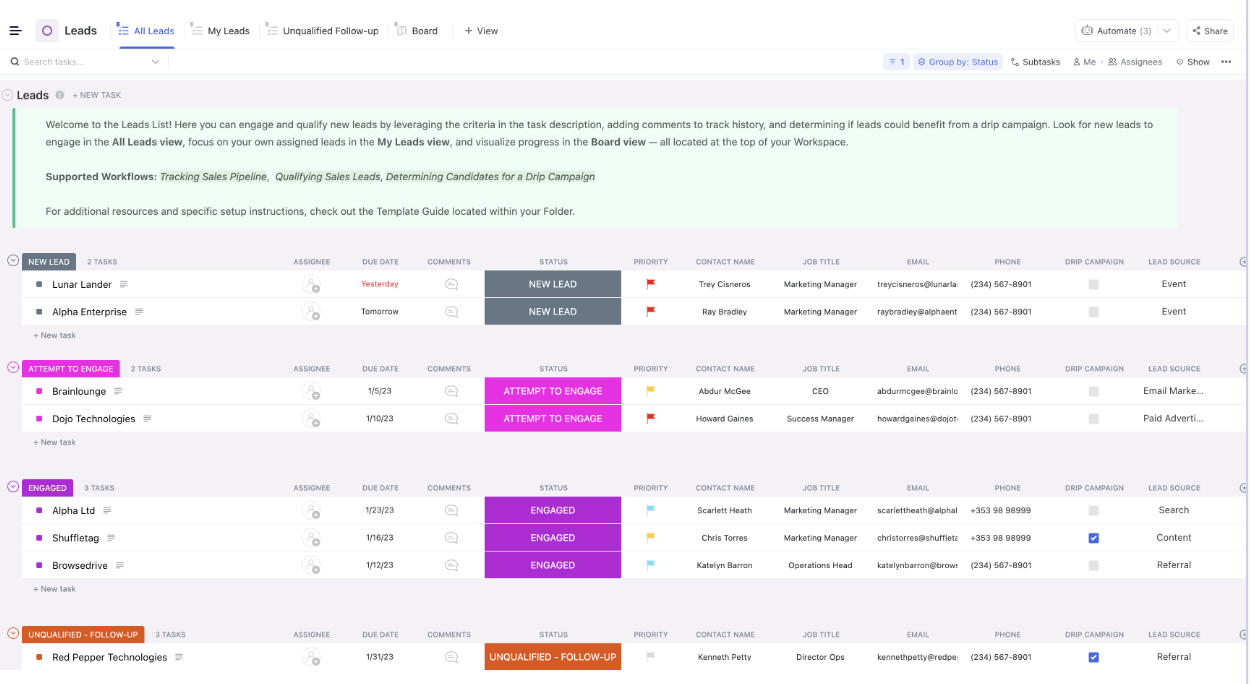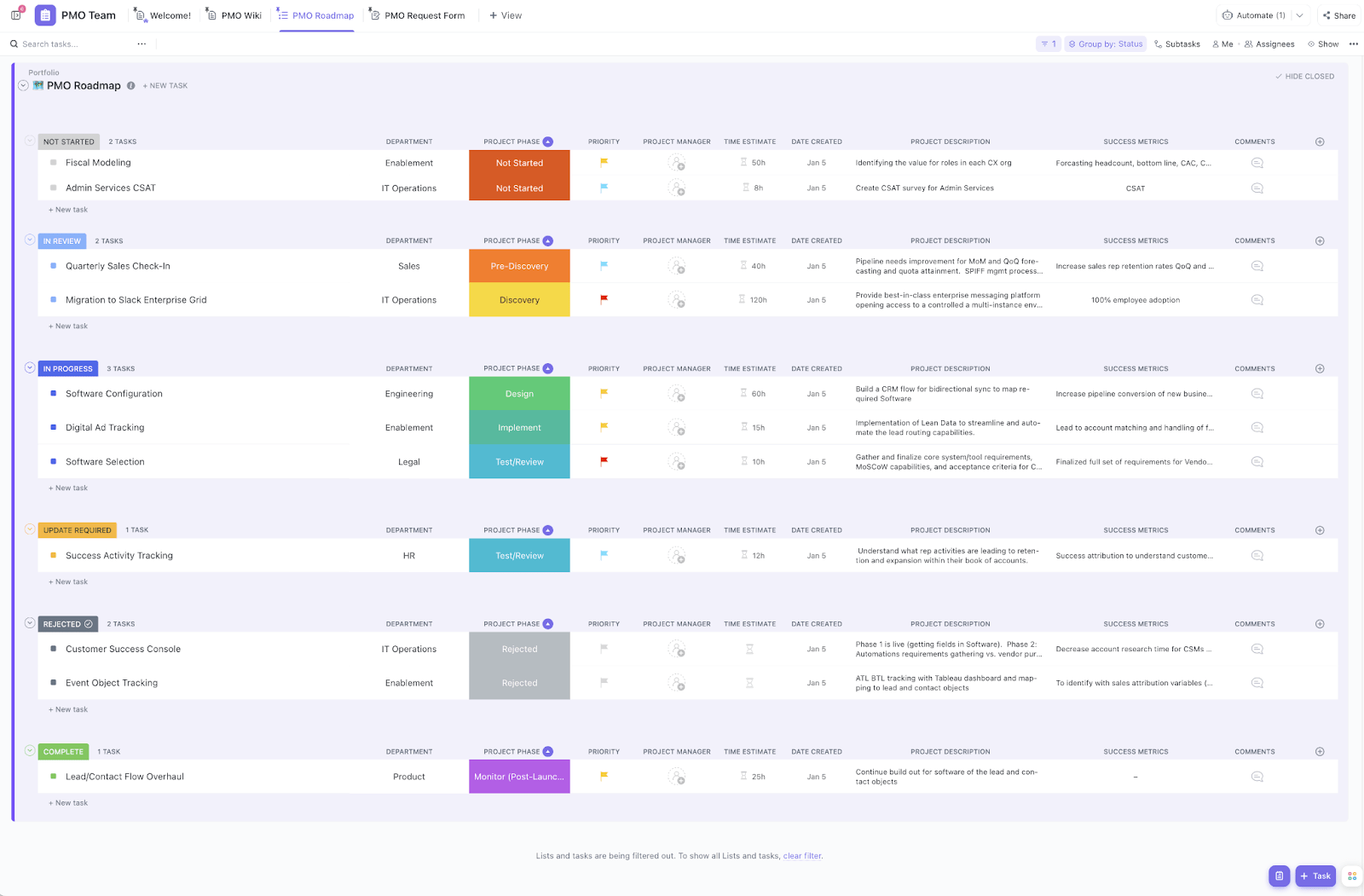لا شك أن العملاء والزبائن هم القوة الدافعة وراء أي عمل تجاري. وتساعد إدارة علاقات العملاء وإدارة المشاريع في الحفاظ على التوازن بينهما. فهي تضمن سلاسة العمليات ورضا العملاء.
خذ Amazon على سبيل المثال. قدرتها على اقتراح منتجات لم تكن تعلم أنك بحاجة إليها؟ هذا هو CRM في العمل. وفي الوقت نفسه، يضمن برنامج إدارة المشاريع أن طلبك متوفر دائمًا في المخزون ويتم تسليمه في الوقت المحدد — لأن رسالة "عذرًا، هذا المنتج غير متوفر" تمثل خسارة فادحة لأي شركة.
وهذا ليس مجرد ميزة إضافية. وفقًا لـ Capterra، شهدت 45% من الشركات زيادة في إيرادات المبيعات بعد تطبيق برنامج CRM فعال.
لذا، دعونا نحلل هذين الأمرين بشكل موضوعي وذاتي، والأهم من ذلك، بطريقة تخدم مصلحتك.
⏰ ملخص في 60 ثانية
اكتشف كيف يعمل دمج حل CRM وإدارة المشاريع على تحسين الكفاءة من خلال الخطوات التالية:
- تساعد CRM الشركات على تتبع العملاء المحتملين وإدارة بيانات العملاء والمشاريع، مما يضمن عدم تفويت أي فرصة
- تساعد برامج إدارة المشاريع على تنظيم الفرق من خلال هيكلة المهام والمواعيد النهائية وتقدم المشاريع
- يؤدي دمج كلاهما إلى تقليل سوء الفهم وتحسين كفاءة سير العمل وأتمتة المهام المتكررة
- تساعد أفضل الممارسات مثل مشاركة المستخدمين، وتنظيف البيانات، وتتبع مؤشرات الأداء الرئيسية الشركات على تحقيق أقصى استفادة من أنظمتها
- يجمع ClickUp بين CRM وإدارة المشاريع في منصة واحدة، مما يقلل التكاليف ويعزز الإنتاجية
ما هو CRM وما هي وظائفه؟
في عام 2000، كان لدى Paul Fulchino خطط كبيرة لشركة Aviall، وهي شركة توزيع قطع غيار الطائرات ومقرها دالاس. كان هدفه هو تحويلها إلى مزود إدارة سلسلة التوريد المفضل لصناعة الطيران.
لكن كانت هناك بعض المشكلات في الطريق، مثل بيانات العملاء الفوضوية والعمليات القديمة:
كان يعلم أن الوقت قد حان لتطبيق CRM، وهذا بالضبط ما فعله:
في غضون أربعة أشهر، تضاعفت المكالمات المبيعية ثلاث مرات، ونمت قاعدة العملاء بنسبة 33٪، وقفزت الطلبات اليومية من 1000 إلى 2500 طلب — دون زيادة عدد الموظفين.
يمكن القول أن هذه اللحظة كانت بداية صعود CRM في استراتيجية الشركات. اليوم، 97% من فرق المبيعات في الولايات المتحدة وكندا تقول إن نظام CRM الخاص بها ضروري لإبرام الصفقات.
ولكن ما هو CRM وما هي وظائفه؟
نظام CRM (إدارة علاقات العملاء) هو حل برمجي يساعد الشركات على إدارة التفاعلات مع العملاء وتتبع العملاء المحتملين وتسهيل جهود المبيعات والتسويق والدعم.
📌 مثال: مارتن، صاحب شركة صغيرة من لوس أنجلوس، يقوم بتأسيس شركته الأولى. إليك ما يقدمه CRM له:
- يخزن وينظم تفاصيل العملاء (الأسماء والبريد الإلكتروني وأرقام الهواتف) حتى لا يضطر إلى البحث عن معلومات الاتصال
- تتبع العملاء المحتملين من أول اتصال إلى التحويل، مما يضمن عدم ضياع أي عميل محتمل
- يسجل جميع تفاعلات العملاء (رسائل البريد الإلكتروني والمكالمات والدردشات) حتى يكون دائمًا على دراية بالسياق قبل التواصل معهم
- يدير مسار المبيعات، مما يمنحه رؤية واضحة عن حالة كل صفقة
➡️ اقرأ أيضًا: أفضل قوالب CRM المجانية: Excel و Google Sheets و ClickUp
📮 ClickUp Insight: 92% من المهنيين يجدون صعوبة في تتبع القرارات المهمة.
وفقًا لبحث أجرته ClickUp، يفقد جزء كبير من العاملين في مجال المعرفة قرارات مهمة بسبب محادثات الدردشة والبريد الإلكتروني وجداول البيانات المتناثرة. بدون نظام مركزي، تضيع الرؤى التجارية المهمة إلى الأبد. يوفر ClickUp أداة لإدارة المهام تتيح لك إنشاء مهام على الفور من الرسائل والتعليقات والمستندات والبريد الإلكتروني، حتى لا تضيع أي معلومات مهمة. هل أنت مستعد لتجربتها؟
ما هو برنامج إدارة المشاريع؟
تخيل الآن أنك حصلت على بيانات عملائك، وأن نظام CRM يعمل بكامل طاقته، وأن مبيعاتك في ازدهار. ولكن بدون إدارة المشاريع، لا تزال تواجه مشكلة كبيرة: لا يمكنك تفويض المهام بشكل فعال.
المشاريع تتأخر، والمواعيد النهائية تتأخر، وفريقك عالق في دوامة لا تنتهي من سوء الفهم. هنا يمكن لبرنامج CRM لإدارة المشاريع أن يتدخل ويساعدك على توزيع المهام بفعالية. فيما يلي بعض مزايا برنامج إدارة المشاريع التي يمكنك توقعها بمجرد بدء استخدامه:
📊 رؤية أفضل للمشاريع: إذا كانت عدة أقسام تعمل على نفس المشروع، فإن منصة إدارة المشاريع تضمن تنسيق العمل بين الفرق وتجنب المواقف التي تقول فيها أحدهم "ظننت أنك تتولى ذلك"
🖇️ إدارة المهام المركزية: لكل شخص طريقته الخاصة في تتبع المهام — الملاحظات اللاصقة أو جداول البيانات أو الذاكرة البشرية (محفوفة بالمخاطر). تجمع أداة إدارة المهام كل شيء تحت سقف واحد وترسل تنبيهات عند اكتمال المهام التابعة
🔍 تقارير دقيقة: القيادة تحب الأرقام. يقوم نظام إدارة المشاريع بسحب البيانات في الوقت الفعلي إلى لوحات المعلومات والتقارير، مما يوفر رؤى واضحة حول تقدم المشروع والربحية والأداء العام للفريق
⌛ تتبع الوقت العالمي: إذا كنت تقوم بفوترة العملاء على أساس ساعات العمل، فأنت بحاجة إلى تتبع دقيق. يسجل نظام CRM لإدارة المشاريع الساعات القابلة للفوترة وغير القابلة للفوترة، مما يساعد على تحديد الأسعار بدقة وفوترة العملاء دون أي لبس
➡️ اقرأ أيضًا: كيفية اختيار نظام CRM لشركتك
بالطبع، هذه ليست سوى بعض الأسباب التي تدفع الشركات إلى الاستثمار في برامج إدارة المشاريع. ولكن على الرغم من أن هذا قد يبدو مبتذلاً، فإنها أكثر من مجرد قائمة مهام رائعة — إنها العمود الفقري الذي يحافظ على سير المشاريع وفرق خدمة العملاء والعلاقات مع العملاء بسلاسة.
💡 نصيحة احترافية: هل تبحث عن نهج أكثر فعالية؟ جرب الجمع بين استراتيجيات إدارة المشاريع الكلاسيكية والأدوات الرقمية الحديثة لتحقيق نتائج أفضل بكثير
مزايا دمج CRM وإدارة المشاريع
وغني عن القول أن الجمع بين برامج CRM وإدارة المشاريع يوفر لك الوقت ويؤدي إلى أتمتة المهام المملة حتى تتمكن من التركيز على نمو أعمالك الحقيقية. ولكن كيف يتم ذلك بالضبط؟ دعنا نحلل ذلك من خلال بعض السيناريوهات الواقعية.
1. مصدر واحد للمعلومات الصحيحة
يؤدي التبديل بين أنظمة متعددة إلى تشتت بيانات العملاء وفقدان التحديثات وتكرار العمل. مع منصة CRM وإدارة المشاريع المتكاملة، يتم توحيد كل شيء بدءًا من تفاعلات العملاء وحتى تفاصيل المشاريع.
📌 مثال: تتعقب شركة استشارية طلبات العملاء والمشاريع والفواتير في نظام واحد، مما يمنع سوء الفهم والتأخير.
2. تنفيذ أسرع للمشاريع
الوقت هو المال، والتأخير يكلف كليهما. باستخدام برنامج إدارة المشاريع CRM، يمكن للفرق تخصيص المهام وتحديد المواعيد النهائية وأتمتة عمليات الموافقة، مما يقلل من الاختناقات ويحافظ على سير العمل وفقًا للجدول الزمني المحدد.
📌 مثال: تعمل شركة تطوير برمجيات على تسريع إطلاق المنتجات من خلال تنسيق فريق المبيعات والمطورين في نظام موحد. يعمل هذا بشكل أساسي كبرنامج لإدارة مشاريع بوابة العملاء لضمان التواصل الواضح بشأن احتياجات العملاء.
3. تحسين رضا العملاء
يريد العملاء الحصول على تحديثات، ولكن ليس 20 رسالة بريد إلكتروني في اليوم. يمنحهم نظام CRM وإدارة المشاريع وصولاً محكومًا إلى تقدم المشروع، مما يقلل من المراسلات غير الضرورية مع الحفاظ على الشفافية.
📌 مثال: تتيح وكالة تسويق للعملاء تتبع حالة الحملات في الوقت الفعلي، مما يقلل الحاجة إلى عقد اجتماعات مستمرة لمتابعة الحالة.
4. تعاون أقوى بين الفرق
غالبًا ما تعمل أقسام المبيعات والتسويق وخدمة العملاء بشكل منفصل. عندما يتم دمج أنظمة إدارة المشاريع و CRM، تظل الفرق على نفس الصفحة، مما يضمن سلاسة عملية التسليم وتقليل الفرص الضائعة.
📌 مثال: يقوم فريق المبيعات بنقل الصفقة بسهولة إلى فريق التنفيذ بمجرد توقيع العقد، مما يقلل من احتكاك عملية التعيين.
5. توفر سير العمل الآلي الوقت
تؤدي الأعمال اليدوية المتكررة إلى إبطاء عمل الفرق. تعمل أدوات إدارة مشاريع CRM على أتمتة العمليات الرئيسية، مثل تخصيص العملاء المحتملين والمتابعة والموافقة على المهام، حتى يتمكن الموظفون من التركيز على المهام الأكثر قيمة.
6. اتخاذ قرارات مستندة إلى البيانات
بدون رؤى، تعمل الشركات على أساس التخمين. يوفر تنفيذ برامج CRM وإدارة المشاريع المتكاملة لوحات معلومات وتقارير في الوقت الفعلي لتتبع الإيرادات وأداء الفريق وكفاءة المشاريع.
🧠 هل تعلم: 48% من المؤسسات تعتبر نفسها مؤسسات تعتمد على البيانات، وهو ما يمثل ضعف النسبة التي كانت 24% فقط في العام السابق، مما يسلط الضوء على التحول السريع نحو اتخاذ القرارات القائمة على التحليلات.
➡️ اقرأ أيضًا: 5 تكاملات CRM لا غنى عنها لعملك
الميزات الرئيسية التي يجب مراعاتها
رائع، الآن بعد أن عرفت أهمية استخدام نظام CRM وإدارة المشاريع، إليك الميزات التي يجب أن تبحث عنها:
- سير عمل قابل للتخصيص: قم بتكييف نظام CRM وإدارة المشاريع ليناسب عملياتك التجارية، من مسارات المبيعات إلى تتبع المشاريع
- قابلية التوسع: تأكد من أن الأداة تنمو مع عملك، وتتعامل مع المشاريع المعقدة، وتوسع نطاق تعاون الفريق دون انقطاع
- واجهة سهلة الاستخدام: يجب أن يكون النظام سهل التصفح، مع الحد الأدنى من التدريب المطلوب للفرق لإدارة المشاريع بكفاءة
- أدوات التعاون: تضمن المراسلة المدمجة ولوحات المعلومات المشتركة وبوابات العملاء أن يظل فريق المشروع وأصحاب المصلحة على نفس الصفحة
- إدارة مركزة للوثائق: قم بتخزين الملفات ومشاركتها وتنظيمها داخل منصة CRM وإدارة المشاريع لتقليل المعلومات المتناثرة
- إشعارات تلقائية: أبقِ الفرق على اطلاع دائم من خلال تنبيهات حول تحديثات المهام والموافقات ومواعيد تسليم المشاريع، مما يمنع إغفال أي إجراءات
💡 نصيحة احترافية: جرب هذه النصائح والحيل المجربة والمختبرة في مجال CRM لتخصيص التفاعلات مع العملاء وتعميق ولائهم ودفع النمو المستدام.
كيف يعمل CRM وإدارة المشاريع معًا
الآن، تخيل الجمع بين جميع الميزات التي ناقشناها للتو مع إدارة مهام استثنائية — هذا هو ClickUp من أجلك.
باعتباره التطبيق الشامل للعمل، يجمع بين ميزتين قويتين لتوحيد CRM وإدارة المشاريع في مساحة عمل واحدة: ClickUp CRM و ClickUp Project Management.
لنبدأ بجانب CRM. ClickUp CRM هو نظام قابل للتكيف بدرجة عالية. لن تكون مقيدًا بهيكل صارم ومسبق الصنع.
أولاً، لديك مسارات قابلة للتخصيص. وهذا يعني أنه يمكنك إنشاء مراحل تتناسب تمامًا مع عملية المبيعات الخاصة بك، من "الاتصال الأولي" إلى "الصفقة المبرمة". الآن، للتصور، لديك خيارات متعددة. عرض القائمة رائع للحصول على نظرة عامة سريعة، ولوحات Kanban تتيح لك سحب الصفقات وإفلاتها عبر مسارك، وعرض الجدول يتيح لك رؤية جميع بياناتك بتنسيق يشبه جدول البيانات.

بالإضافة إلى ذلك، يمكنك إنشاء حقول مخصصة لتتبع المعلومات المحددة المهمة لعملك، مثل الصناعة أو مصدر العملاء المحتملين أو قيمة الصفقة. يقضي العديد من مديري المشاريع وقتًا طويلاً في متابعة العلاقات وترابط المهام، ولكن ClickUp يحل هذه المشكلة من خلال أكثر من 15 عرضًا مخصصًا.

ثم هناك قاعدة بيانات جهات الاتصال المركزية. وهي مساحة ديناميكية حيث يمكنك تخزين المعلومات التفصيلية وسجل الاتصالات والملفات ذات الصلة لكل عميل محتمل أو عميل حالي. يقوم ClickUp بتنظيم تفاصيل مشروعك ومعلومات عملائك في تنسيق هرمي واضح عبر المساحات والمجلدات والقوائم والمهام والمهام الفرعية.
فيما يتعلق بالمهام، تعزز ClickUp Tasks بشكل كبير وظائف CRM من خلال توفير رابط مباشر بين تفاعلات العملاء والخطوات القابلة للتنفيذ.
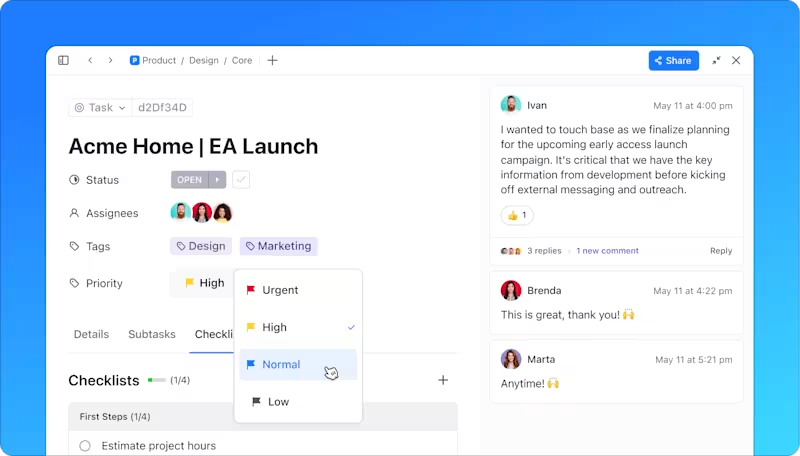
يمكن أن يكون لكل عميل محتمل أو عميل مهام مرتبطة به، مما يضمن عدم تفويت أي متابعة أو اجتماع أو نتائج. يمكنك تعيين المهام لأعضاء الفريق وتحديد المواعيد النهائية وتتبع التقدم المحرز في سياق علاقة العميل. يتيح هذا التكامل تعاونًا سلسًا، مما يضمن تسجيل كل نقطة اتصال واتخاذ الإجراءات اللازمة بشأنها.
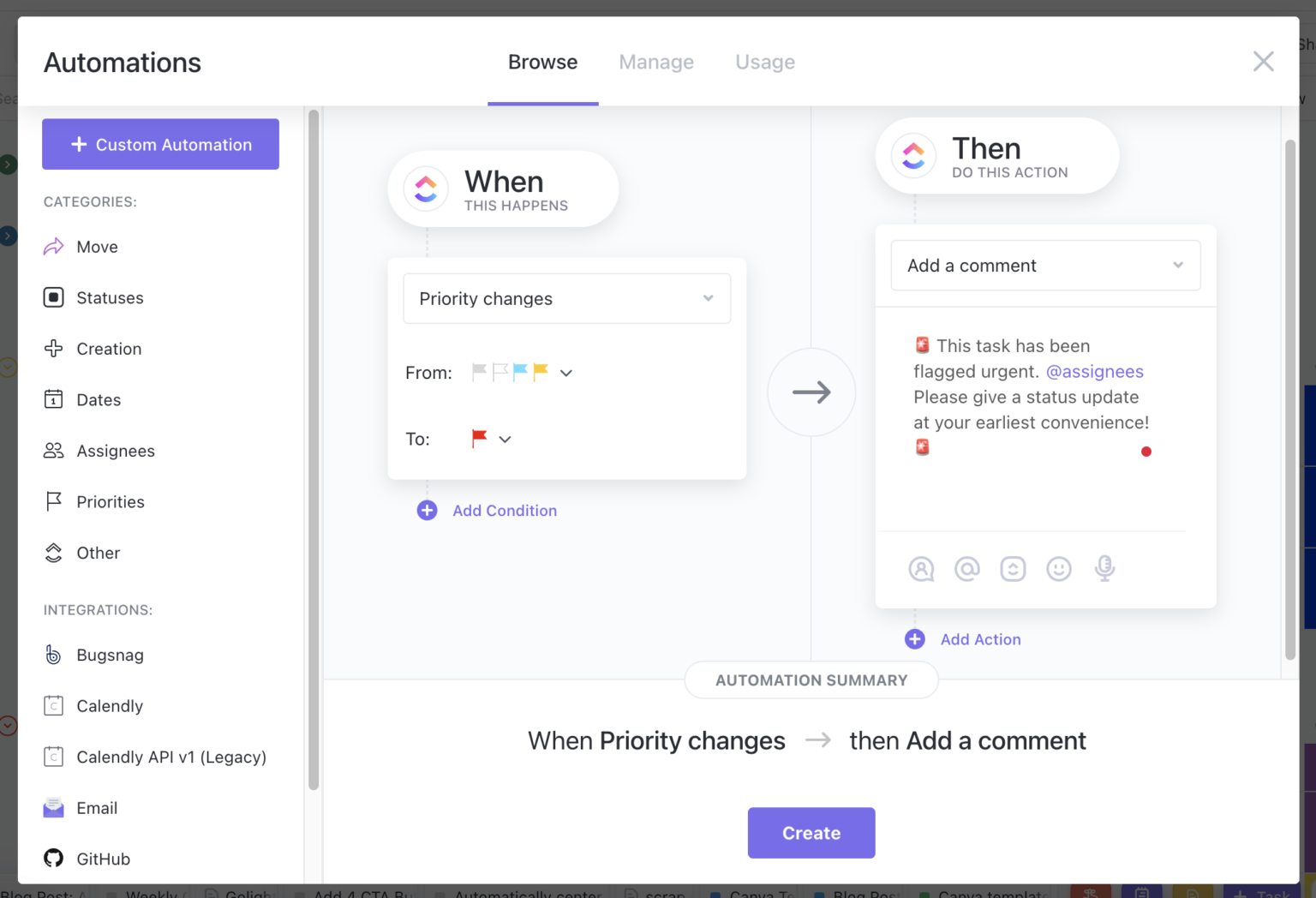
لتعزيز سير عمل CRM، استفد من ترابط المهام والأتمتة. من إنشاء مهام المتابعة تلقائيًا بعد الاجتماع إلى تحديث حالة الصفقات بناءً على إتمام المهام، تساعدك هذه الميزات في إدارة العملاء بكفاءة وتحسين معدلات التحويل.
📌 مثال: لنفترض أنك تدير حملة إخبارية. بدلاً من تتبع كل عميل محتمل يدويًا:
تسجيل عميل جديد → وضع علامة تلقائية في CRM → تعيين مهمة متابعة → جدولة النشرة الإخبارية
ولتتبع أدائك، يمكنك إنشاء لوحات معلومات باستخدام أدوات مخصصة لتصور المقاييس الرئيسية مثل معدلات التحويل وإيرادات المبيعات وأداء الفريق. في الأساس، يهدف ClickUp CRM إلى منحك المرونة اللازمة لإنشاء نظام CRM يعمل بالطريقة التي تريدها تمامًا.
إذا كنت تريد الحصول على لمحة مرئية عن معدلات إنجاز المهام أو أداء الفريق أو كفاءة الأتمتة، فما عليك سوى إنشاء لوحة معلومات ClickUp مخصصة.
يمكنك الاختيار من بين أكثر من 50 بطاقة لتتبع تقدم المهام وتوزيع عبء العمل وتتبع الأهداف، ثم مشاركة لوحة المعلومات مع فريقك أو عملائك لتحقيق الشفافية الكاملة.

غالبًا ما تنشئ فرق نجاح العملاء لوحات معلومات CRM لمراقبة حالة العملاء وتحديد المخاطر وتتبع فرص النمو المحتملة.
💡 نصيحة احترافية: مع ClickUp Brain، تصبح لوحة التحكم الخاصة بك أكثر ذكاءً. بدلاً من البحث يدويًا في البيانات، ما عليك سوى سؤال الذكاء الاصطناعي، وسيقوم على الفور باسترداد المعلومات من نظام إدارة المشاريع الخاص بك.
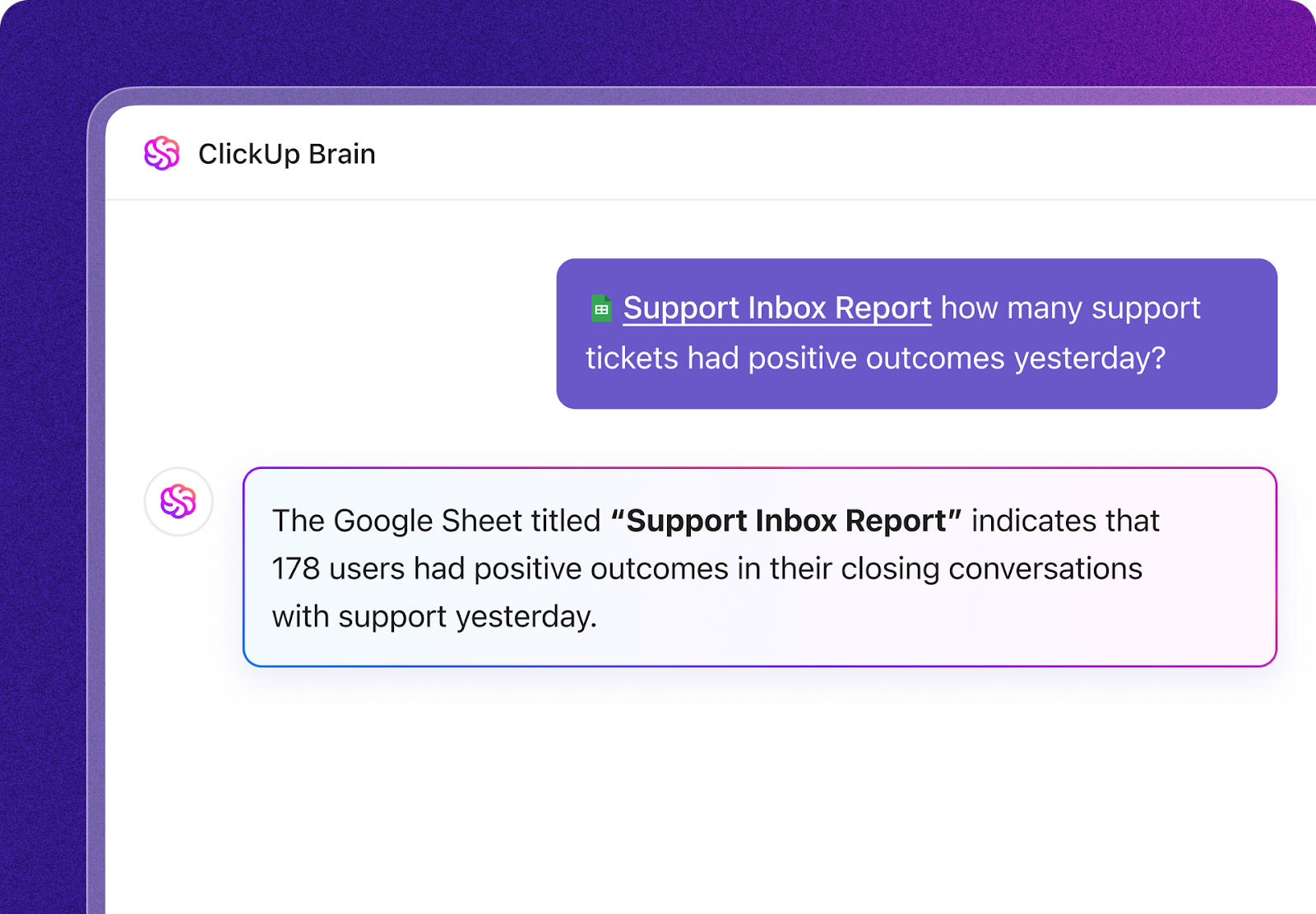
إذا كنت تبدأ من الصفر، فإن قالب CRM من ClickUp يوفر نظامًا خفيفًا ولكنه قوي لإدارة علاقات العملاء.
إليك كل ما يمكنك القيام به باستخدام القالب:
- تتبع العملاء المحتملين والصفقات والحسابات وجهات الاتصال
- تأهيل العملاء المحتملين، والفوز بالصفقات بشكل أسرع، وتعزيز العلاقات مع العملاء
- إدارة مراحل المبيعات باستخدام سير عمل واضح وبصري
الآن إلى جوهر إدارة المشاريع: التعاون. يتيح ClickUp للفرق العمل معًا في الوقت الفعلي عبر:
مستندات ClickUp
يتيح لك ClickUp Docs إنشاء ملفات تعريف مفصلة للعملاء وملاحظات الاجتماعات ووثائق العروض، وتحريرها مباشرةً لضمان توافق الجميع. تعمل القدرة على تعيين عناصر العمل مباشرةً داخل المستندات على تحويل هذه الملاحظات إلى مهام قابلة للتنفيذ، مما يضمن عدم تفويت أي متابعة. في إدارة المشاريع، يسهل Docs إنشاء مواصفات المشاريع وجداول أعمال الاجتماعات وقواعد المعرفة، مما يعزز التواصل الواضح والمساءلة.
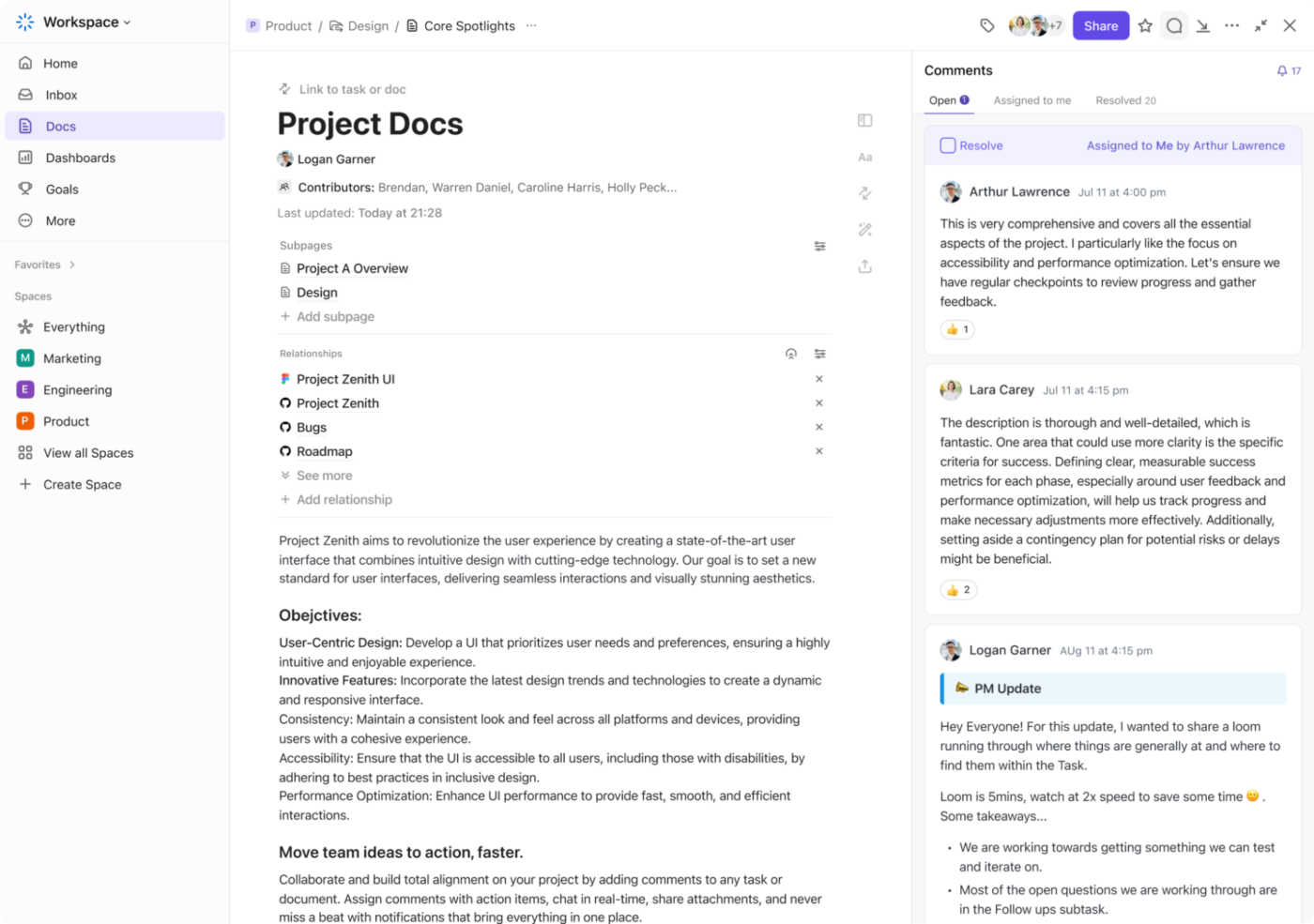
لوحات ClickUp البيضاء وخرائط ClickUp الذهنية
يمكن أن تساعد لوحات ClickUp البيضاء وخرائط ClickUp الذهنية الفرق على تصور رحلات العملاء، ورسم استراتيجيات المبيعات، وطرح حلول للتحديات التي يواجهها العملاء. بالنسبة لإدارة المشاريع، تسهل هذه الأدوات تخطيط المشاريع وتقسيم المهام وتوليد الأفكار، مما يتيح للفرق تنظيم المشاريع المعقدة بصريًا وتحديد التبعيات. من خلال توفير مساحة مرئية مشتركة، تعزز هذه الميزات التعاون وتحسن الفهم وتسهل حل المشكلات بطريقة إبداعية
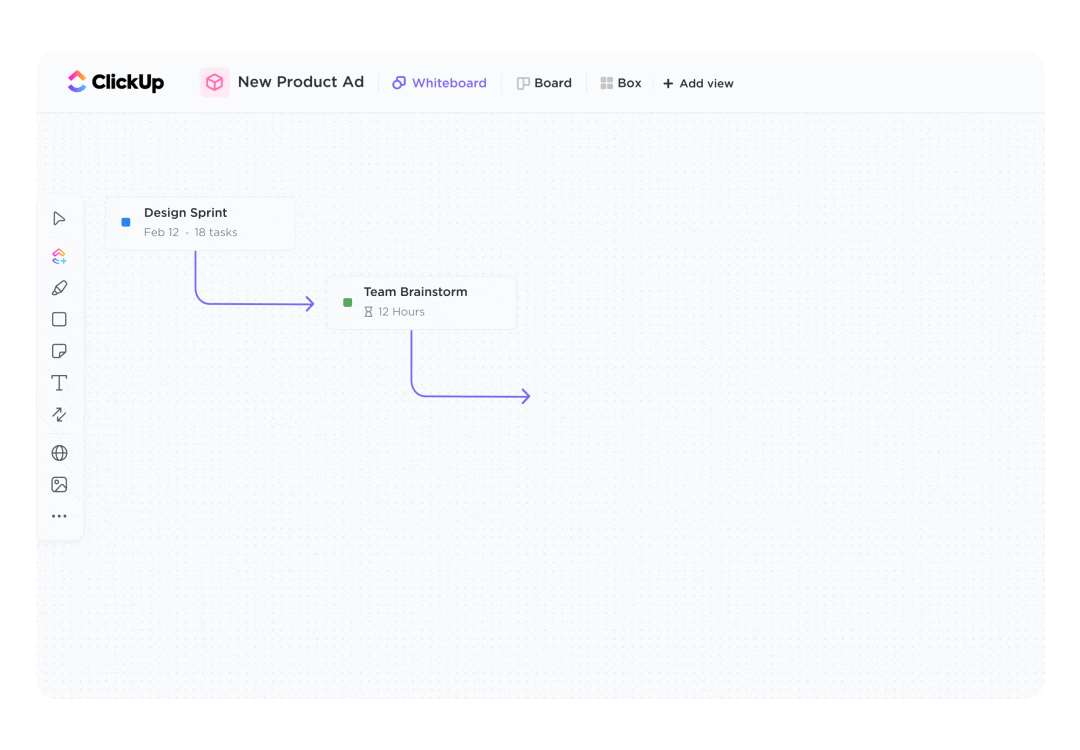
أخيرًا، لا ينبغي أن يتطلب حل CRM وإدارة المشاريع الجيد التبديل المستمر بين التطبيقات. تضمن تكامل ClickUp مع أكثر من 1000 أداة، بما في ذلك Slack و Gmail و Zoom و Outlook و HubSpot، سير العمل بسلاسة في جميع عمليات شركتك.
كما قال أرنولد روجرز، مدير دعم العملاء في Launch Control:
لقد قمنا بدمج Intercom و Stripe و ChurnZero و Slack و Gmail و ProfitWell وغيرها. وهذا يتيح لنا تتبع الشؤون المالية والاحتفاظ بالعملاء وإعداد التقارير وتفاصيل العملاء في مكان واحد، حيث يمكننا سحب المعلومات من جميع الأدوات التي نستخدمها وتجميعها في ClickUp لسهولة الاستخدام دون الحاجة إلى إشراك جميع الأقسام وأخذ وقت من جداولهم
لقد قمنا بدمج Intercom و Stripe و ChurnZero و Slack و Gmail و ProfitWell وغيرها. وهذا يتيح لنا تتبع الشؤون المالية والاحتفاظ بالعملاء وإعداد التقارير وتفاصيل العملاء في مكان واحد، حيث يمكننا سحب المعلومات من جميع الأدوات التي نستخدمها وتجميعها في ClickUp لسهولة الاستخدام دون إشراك جميع الأقسام وأخذ وقت من جداولهم
وإذا كنت لا تزال تواجه صعوبة في الاحتفاظ بكل شيء في مكان واحد، فما عليك سوى التبديل إلى نموذج إدارة المشاريع من ClickUp.
يساعد مديري المشاريع ومديري البرامج ومديري المحافظ على كسر الحواجز، والقضاء على العقبات، وتنفيذ المشاريع بكفاءة من خلال تتبع المهام المدمج.
أفضل الممارسات لتكامل CRM وإدارة المشاريع
قد يصبح دمج CRM وأفضل أدوات إدارة المشاريع بنجاح أمرًا صعبًا في بعض الأحيان. إليك كيفية القيام بذلك بشكل صحيح:
- مشاركة المستخدمين: أشرك فريقك في مرحلة مبكرة من عملية التكامل. يجب أن يكون للأشخاص الذين يستخدمون النظام يوميًا رأي في كيفية عمله
- جودة البيانات: قم بتنظيف التكرارات والإدخالات القديمة والتناقضات لتجنب المشاكل المستقبلية
- حدد مراحل المشروع بوضوح: حدد المعالم الرئيسية والجداول الزمنية والتبعيات داخل CRM لتوفير رؤية واضحة لتقدم المشروع
- توفير التدريب المناسب: حتى أفضل منصة CRM وإدارة المشاريع تكون عديمة الفائدة إذا كان فريقك لا يعرف كيفية استخدامها
- مراقبة مؤشرات الأداء الرئيسية: راقب مقاييس CRM مثل معدلات إنجاز المهام وحركة المبيعات ودرجات رضا العملاء لقياس النجاح
- مزامنة بيانات العملاء: ضمان التحديثات في الوقت الفعلي عبر كلا النظامين حتى لا يعمل أي شخص بمعلومات قديمة
اختر ClickUp لتحقيق كفاءة مذهلة
قد تجعلك إدارة علاقات العملاء مع الحفاظ على سير المشاريع على المسار الصحيح تشعر بأنك مشغول دائمًا.
هذا هو السبب في أن ClickUp جيد جدًا في تخفيف العبء عنك من خلال تبسيط وإدارة المهام والأتمتة و CRM وإدارة المشاريع الجيدة في مكان واحد.
- QubicaAMF وفرت أكثر من 5 ساعات أسبوعيًا كانت تضيع في البحث عن المعلومات
- خفضت RevPartners التكاليف بنسبة 50٪ من خلال دمج ثلاثة أدوات في أداة واحدة
- وفرت Lulu Press ساعة واحدة يوميًا لكل موظف باستخدام ClickUp Automations، مما أدى إلى زيادة كفاءة العمل بنسبة 12٪
هذه ليست مصادفات، بل دليل على أن ClickUp هو الحل الشامل لنجاح CRM وإدارة المشاريع.
سجل الآن على ClickUp واجعل حياة فريقك أسهل وأكثر إنتاجية.
